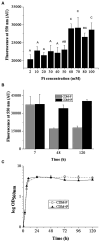Inorganic phosphate modifies stationary phase fitness and metabolic pathways in Lactiplantibacillus paraplantarum CRL 1905
- PMID: 38476941
- PMCID: PMC10927959
- DOI: 10.3389/fmicb.2024.1343541
Inorganic phosphate modifies stationary phase fitness and metabolic pathways in Lactiplantibacillus paraplantarum CRL 1905
Abstract
Inorganic phosphate (Pi) concentration modulates polyphosphate (polyP) levels in diverse bacteria, affecting their physiology and survival. Lactiplantibacillus paraplantarum CRL 1905 is a lactic acid bacterium isolated from quinoa sourdough with biotechnological potential as starter, for initiating fermentation processes in food, and as antimicrobial-producing organism. The aim of this work was to evaluate the influence of the environmental Pi concentration on different physiological and molecular aspects of the CRL 1905 strain. Cells grown in a chemically defined medium containing high Pi (CDM + P) maintained elevated polyP levels up to late stationary phase and showed an enhanced bacterial survival and tolerance to oxidative stress. In Pi sufficiency condition (CDM-P), cells were ~ 25% longer than those grown in CDM + P, presented membrane vesicles and a ~ 3-fold higher capacity to form biofilm. Proteomic analysis indicated that proteins involved in the "carbohydrate transport and metabolism" and "energy production and conversion" categories were up-regulated in high Pi stationary phase cells, implying an active metabolism in this condition. On the other hand, stress-related chaperones and enzymes involved in cell surface modification were up-regulated in the CDM-P medium. Our results provide new insights to understand the CRL 1905 adaptations in response to differential Pi conditions. The adjustment of environmental Pi concentration constitutes a simple strategy to improve the cellular fitness of L. paraplantarum CRL 1905, which would benefit its potential as a microbial cell factory.
Keywords: biofilm; lactic acid bacteria; polyphosphate; proteomics; stationary phase.
Copyright © 2024 Araoz, Grillo-Puertas, de Moreno de LeBlanc, Hebert, Villegas and Rapisarda.
Conflict of interest statement
The authors declare that the research was conducted in the absence of any commercial or financial relationships that could be construed as a potential conflict of interest.
Figures




References
-
- Alqarzaee A. A., Chaudhari S. S., Islam M. M., Kumar V., Zimmerman M. C., Saha R., et al. . (2021). Staphylococcal ClpXP protease targets the cellular antioxidant system to eliminate fitness-compromised cells in stationary phase. Proc. Natl. Acad. Sci. 118:e2109671118. doi: 10.1073/pnas.2109671118, PMID: - DOI - PMC - PubMed
-
- Alvarez-Martin P., Fernández M., O'Connell-Motherway M., O'Connell K. J., Sauvageot N., Fitzgerald G. F., et al. . (2012). A conserved two-component signal transduction system controls the response to phosphate starvation in Bifidobacterium breve UCC2003. Appl. Environ. Microbiol. 78, 5258–5269. doi: 10.1128/AEM.00804-12, PMID: - DOI - PMC - PubMed
LinkOut - more resources
Full Text Sources
Research Materials
Miscellaneous

